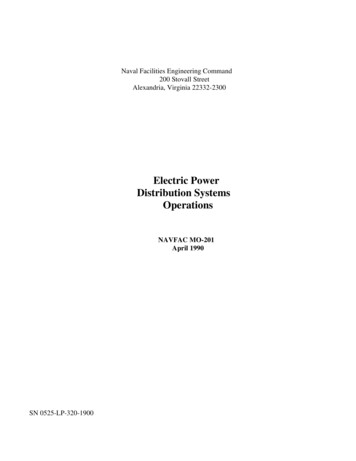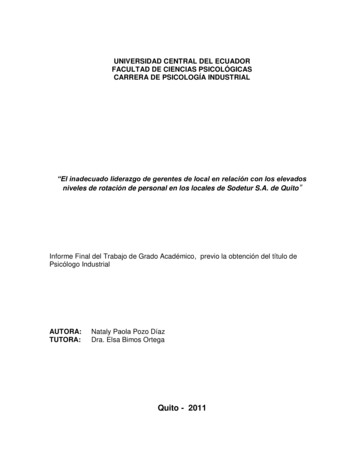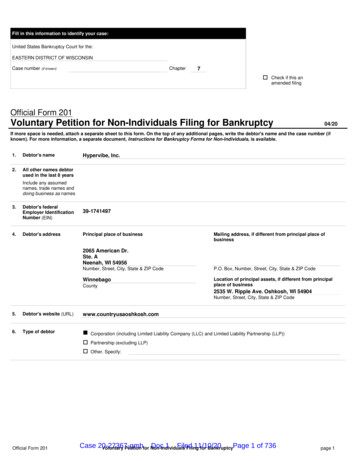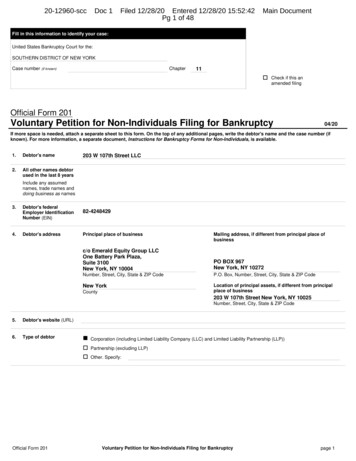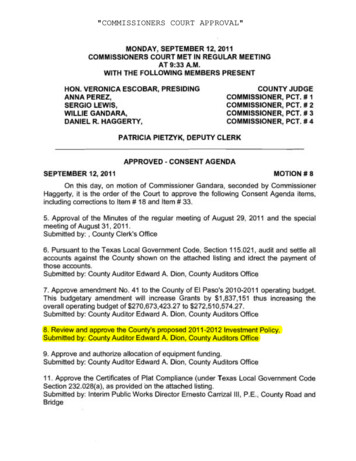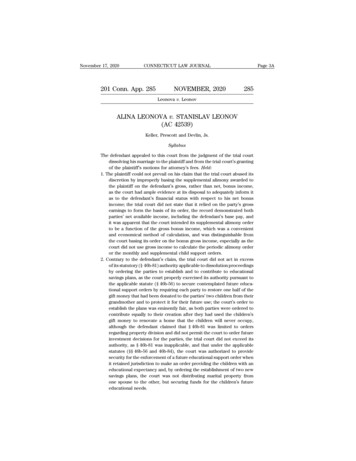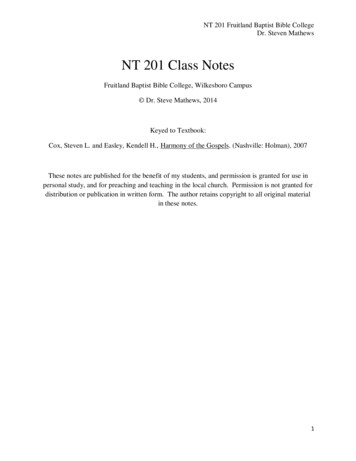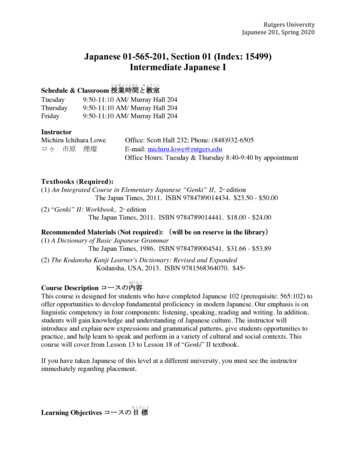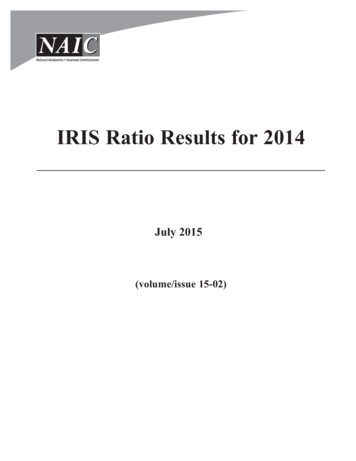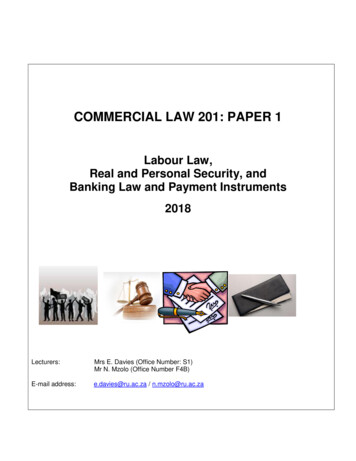
Transcription
COMMERCIAL LAW 201: PAPER 1Labour Law,Real and Personal Security, andBanking Law and Payment Instruments2018Lecturers:Mrs E. Davies (Office Number: S1)Mr N. Mzolo (Office Number F4B)E-mail address:e.davies@ru.ac.za / n.mzolo@ru.ac.za
1.INTRODUCTIONWelcome to Commercial Law 201, Paper 1 in 2018. This is a component course of Commercial Law 201.Upon completion of this course, students should have a broad overview of the legal principles of LabourLaw, Real and Personal Security and Banking Law & Forms of Payment and should be able to applythese principles in the commercial accounting profession. It includes the three modules for this course,namely:(a)Labour Law;(b)Real and Personal Security; and(c)The Law of Banking and Payment Instruments.Labour law, real and personal security, and banking law and payment instruments together form one oftwo Commercial Law courses offered in the first semester to second year level students registered in theFaculty of Commerce (COL 201, paper 1 and COL 201, paper 2). Approximately 50% of the course isdedicated to labour law and the remaining 50% will be divided between real and personal security andbanking law and payments. The purpose and outcomes of the course follow and expand upon the SouthAfrican Institute for Chartered Accountants’ (SAICA) recommendations for law courses.In general, the course aims to provide insight into the nature and function of these areas of law in SouthAfrica. In particular, the course aims to ensure that students have insight into the principles governingemployment and labour contracts, the rights and responsibilities of employers and employees, the lawrelating to mortgages and pledges, as well as suretyship agreements, and finally the law relating to billsof exchange, promissory notes, cheques and electronic payments. In addition, the purpose of the courseis to introduce students to the relevant legislation relating to each topic and to give them an understandingof some of the more common legal situations which can arise in a labour or banking relationship and howsituations are dealt with by the law.1.1 Credit ValueThe course contains 7.5 Credits which translates into 7.5 hours to be spent on this course per week.There are two 45 minutes’ lectures per week.1.2 Assumptions of Prior LearningIn order successfully to complete this course, students need to be able to: be capable of writing and communicating in coherent English.2 P age
have a basic working knowledge of the South African legal system, legal terminology and the generalprinciples of contract learnt and applied in Commercial Law 101. know how and where to access resources such as textbooks, law reports and statutes in the LawLibrary and on the intranet. be capable of independent learning. be able to identify and apply legal principles to a set of facts given; and be capable of solving problems.2. OUTCOMES2.1 Critical OutcomesStudents will be able to: demonstrate knowledge of employment law; distinguish between employees and independent contractors; identify essential elements of labour law; critically understand the duties of employers and employees; understand the framework of lawful termination of contract of employment; critically apply principles of labour law to solve practical problems; demonstrate knowledge of the objectives and rationale of security; distinguish between real and personal security; identify different types of real and personal security; understand the formalities and requirements that accrue from security; describe the origins of negotiable instruments; describe the sources of negotiable instruments in South Africa; identify basic concepts, definitions, parties and functions of a bill of exchange; identify and understand the requirements of a negotiable instrument; organise and manage themselves and their work load; communicate effectively in class debate and class assessments; use technology in legal research; and analyse and evaluate information.3 P age
2.2 Intended Specific OutcomesThe course is designed so that students successfully completing this course should be able to achievethe following outcomes: To understand and explain the essential elements of a valid contract of employment To be able differentiate between employees and independent contractors To understand and explain some of the key legal consequences of a contract of employment. To understand and explain the various types of dismissal from employment To understand and explain the legal duties that are imposed upon parties, and the consequencesthat flow if these duties are breached. Apply the knowledge acquired during the course to solve practical problems with regard to specificcontracts. To recognise and explain the features of special contracts, particularly those regulated by statutes. To understand and explain the legal consequences of suretyship agreements, as well as mortgageand pledge agreements. To understand and explain the legal consequences and duties of the parties to cheques, promissorynotes and bills of exchange.3.TEACHING METHODSLectures will be delivered in a semi-socratic style, using practical questions and real life examples as abasis for explaining concepts. Students are expected to assume responsibility for their learning byreading in advance to help understand the course content easily.4.ASSESSMENTThere will be two formal tests for Commercial Law 201: Paper 1 which will count 30% towards the finalmark. There will also be a two-hour examination in June that will count 70% of the course componenttowards final mark.TEST DATESTest No. 1:02 March 2018 (in the lecture venue at 8:40am)Test No. 2:07 May 2018 (in the lecture venue at 9:35am)4 P age
Students will be presented with typical examination questions during lectures from time to time. Thesequestions will cover material already lectured upon and students will be guided through the process ofanswering these questions. This exercise will enable students to have instant feedback on how well theyhave assimilated knowledge.5.COURSE CONTENT5.1Labour Law Introduction to Labour Law Employees and independent contractors Definition and essential elements Relations between the parties Automatically unfair dismissal Dismissal for misconduct Dismissal for incapacity Dismissal for operational requirements Remedies for termination5.2Real and Personal Security Introduction Real security Personal security5.3Banking Law and Forms of Payment Introduction Sources Basic concepts, definitions, parties and functions of negotiable instruments Formal requirements of negotiable instruments Types of holders Bank/customer relationship Debit and credit cards FICA5 P age
6.STUDENT ASSESSMENTSpecific outcomesAssessment criteriaTo understand andexplain the essentialelements of a validcontract of suretyship,mortgage, pledge orlabour Define and explain the essentialelements of the specific contractsstudied in the course. Apply any relevant statutory andcommon law principles to specificcontracts.To understand andexplain the legalobligations that areimposed upon partiesto specific contracts,and the consequencesthat flow if these dutiesare breached. Define and explain the variouslegal duties of parties to specificcontracts.Apply the knowledgeacquired during thecourse to solvepractical problems withregard to specificcontracts. To recognise andexplain the features ofspecial contracts,particularly thoseregulated by statute. Assessment tasks Class discussion andquestioning. Problem and theoryquestions in tests andexaminations. Class discussion andquestioning. Problem and theoryquestions in tests andexaminations.Identify and discuss the relevantlegal problem or issue.Apply the applicable law to thelegal problem or issue.Conclude with reference toremedies available, ifappropriate. Class discussion andquestioning. Problem and theoryquestions in tests andexaminations.Discuss the important or uniquefeatures of special contracts.Discuss the legal requirementsthat attach to certain contractsregulated by statutoryenactments. Class discussion andquestioning. Problem and theoryquestions in tests andexaminations.6 P age
7.RESOURCESPlease note that there are no prescribed texts for this course. However, there are several generalCommercial Law textbooks which are very useful, as well as the relevant volumes of LAWSA (the Lawof South Africa) which you will be able to find in the reference section of the Law Library (see someexamples listed below). You will also need to consult legislation from time to time (specifically in referenceto labour law). Legislation can be accessed on the internet via the Rhodes library webpage.S KopelGuide to Business Law (2012) OUP: Cape Town.This textbook is particularly recommended as it covers the topics in Com Law 201 as well as 202Schultz et alGeneral principles Commercial Law 8 ed (2015) Juta and Company: ClaremontScott et alThe Law of Commerce in South Africa 2nd ed. (2015) Oxford University PressSouthern Africa: Cape Town7 P age
Lectures will be delivered in a semi-socratic style, using practical questions and real life examples as a basis for explaining concepts. Students are expected to assume responsibility for their learning by reading in advance to help understand the course content easily. 4. ASSESSMENT There will be two formal tests for Commercial Law 201: Paper 1 which will count 30% towards the final mark .

